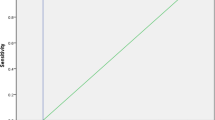Abstract
Introduction and hypothesis
The vagina and surrounding structures have been shown to remodel during pregnancy. Our objective was to characterize the biomechanical properties of the vagina in the rodent model in vivo utilizing three-dimensional (3D) ultrasound.
Methods
The vagina was visualized by ultrasound after distention by increasing pressures throughout pregnancy (15 and 18 days) and after vaginal delivery (7 and 30 days postpartum) of six longitudinally followed rodents. The pelvic floor compliance and vaginal cross-sectional area of the proximal, middle, and distal vagina were compared with those of nulliparous control animals (n = 8).
Results
The compliance of the pelvic floor increased 3.5- and 5.4-fold at days 15 and 18 of pregnancy respectively (p < 0.05). The compliance of the pelvic floor decreased 7 days postpartum, and it continued to decrease after vaginal delivery through the 30 day time point. Using 3D ultrasound, we could characterize the remodeling of the vagina throughout pregnancy and after vaginal delivery. We could reconstruct the vaginal wall cross-sectional area and found the distal vaginal wall throughout pregnancy to be distended more than the proximal and middle regions.
Conclusions
The observed changes in vaginal area may improve our understanding of which areas are at risk of injury during delivery. Further, 3D ultrasound allowed the determination of the in vivo biomechanical properties of the vagina. This image modality is beneficial for characterizing the in vivo properties of the vagina and surrounding pelvic support longitudinally within an animal.





Similar content being viewed by others
References
Lawrence JM, Lukacz ES, Nager CW, Hsu JW, Luber KM (2008) Prevalence and co-occurrence of pelvic floor disorders in community-dwelling women. Obstet Gynecol 111(3):678–685
Hunskaar S, Vinsnes A (1991) The quality of life in women with urinary incontinence as measured by the sickness impact profile. J Am Geriatr Soc 39(4):378–382
Mardon RE, Halim S, Pawlson LG, Haffer SC (2006) Management of urinary incontinence in Medicare managed care beneficiaries: results from the 2004 Medicare Health Outcomes Survey. Arch Intern Med 166(10):1128–1133
Delancey JO, Kane Low L, Miller JM, Patel DA, Tumbarello JA (2008) Graphic integration of causal factors of pelvic floor disorders: an integrated life span model. Am J Obstet Gynecol 199(6):610.e1–610.e5
DeLancey JO (2005) The hidden epidemic of pelvic floor dysfunction: achievable goals for improved prevention and treatment. Am J Obstet Gynecol 192(5):1488–1495
Drutz HP, Alarab M (2006) Pelvic organ prolapse: demographics and future growth prospects. Int Urogynecol J Pelvic Floor Dysfunct 17 [Suppl 7]:S6–S9
Boyles SH, Weber AM, Meyn L (2003) Procedures for pelvic organ prolapse in the United States, 1979-1997. Am J Obstet Gynecol 188(1):108–115
Brown JS, Waetjen LE, Subak LL, Thom DH, Van den Eeden S, Vittinghoff E (2002) Pelvic organ prolapse surgery in the United States, 1997. Am J Obstet Gynecol 186(4):712–716
Subak LL, Waetjen LE, van den Eeden S, Thom DH, Vittinghoff E, Brown JS (2001) Cost of pelvic organ prolapse surgery in the United States. Obstet Gynecol 98(4):646–651
Food and Drug Administration Public Health Notification 2011: http://www.fda.gov/MedicalDevices/Safety/AlertsandNotices/ucm262435.htm
Olsen AL, Smith VJ, Bergstrom JO, Colling JC, Clark AL (1997) Epidemiology of surgically managed pelvic organ prolapse and urinary incontinence. Obstet Gynecol 89(4):501–506
Dietz HP, Wilson PD (2005) Childbirth and pelvic floor trauma. Best Pract Res Clin Obstet Gynaecol 19(6):913–924
Feola A, Moalli P, Alperin M, Duerr R, Gandley RE, Abramowitch S (2011) Impact of pregnancy and vaginal delivery on the passive and active mechanics of the rat vagina. Ann Biomed Eng 39(1):549–558
Lowder JL, Debes KM, Moon DK, Howden N, Abramowitch SD, Moalli PA (2007) Biomechanical adaptations of the rat vagina and supportive tissues in pregnancy to accommodate delivery. Obstet Gynecol 109(1):136–143
Alperin M, Feola A, Duerr R, Moalli P, Abramowitch S (2010) Pregnancy- and delivery-induced biomechanical changes in rat vagina persist postpartum. Int Urogynecol J Pelvic Floor Dysfunct 21(9):1169–1174
Dietz HP (2010) Pelvic floor ultrasound: a review. Am J Obstet Gynecol 202(4):321–334
Thakar R, Sultan AH (2004) Anal endosonography and its role in assessing the incontinent patient. Best Pract Res Clin Obstet Gynaecol 18(1):157–173
DeLancey JO, Morgan DM, Fenner DE, Kearney R, Guire K, Miller JM, Hussain H, Umek W, Hsu Y, Ashton-Miller JA (2007) Comparison of levator ani muscle defects and function in women with and without pelvic organ prolapse. Obstet Gynecol 109(2 Pt 1):295–302
Ashton-Miller JA, Delancey JO (2009) On the biomechanics of vaginal birth and common sequelae. Annu Rev Biomed Eng 11:163–176
Dietz HP (2006) Pelvic floor trauma following vaginal delivery. Curr Opin Obstet Gynecol 18(5):528–537
Acknowledgements
AF and ME are beneficiaries of a Marie Curie Industria-Academia Partnership and Pathways grant sponsored by the European Commission (251356), JPD receives a fundamental clinical research grant of the Fonds Wetenschappelijk Onderzoek Vlaanderen (1.8.012.07.N). The VEVO platform was funded by the Hercules Foundation of the Flemish Government.
Conflicts of interest
None.
Author information
Authors and Affiliations
Corresponding author
Rights and permissions
About this article
Cite this article
Feola, A., Endo, M. & Deprest, J. Biomechanics of the rat vagina during pregnancy and postpartum: a 3-dimensional ultrasound approach. Int Urogynecol J 25, 915–920 (2014). https://doi.org/10.1007/s00192-013-2313-6
Received:
Accepted:
Published:
Issue Date:
DOI: https://doi.org/10.1007/s00192-013-2313-6




